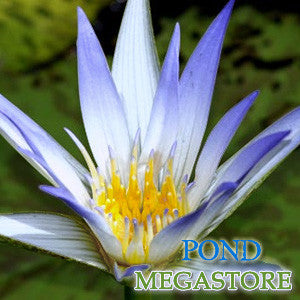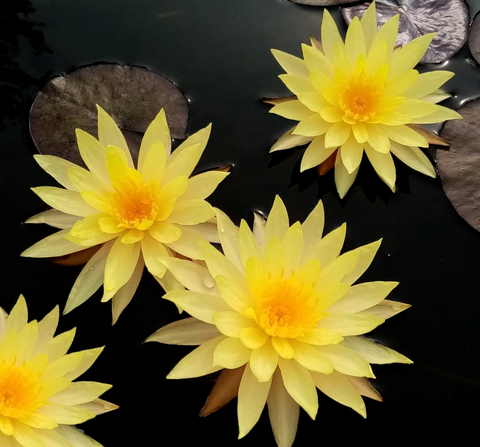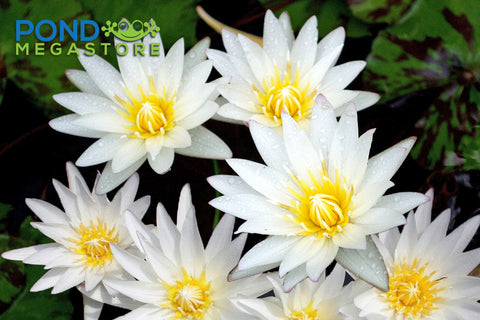Cerulea Waterlily (Blue Lotus of the Nile)
Also known as Egyptian Blue Lotus, Sacred Blue Lily of the Nile
A Plant with History and Beauty
For centuries, the Cerulea Waterlily has captured imaginations—from ancient Egyptian temples to today’s backyard ponds. Its light-blue, star-shaped flowers rise gracefully above the water, set against glossy green pads. Unlike true lotuses, the Cerulea is a tropical waterlily—ideal for adding exotic color and elegance to your pond all summer long.
This is more than just a pretty flower. The Cerulea helps shade your pond, reducing string algae and green water naturally, without chemicals. Its surface cover provides shelter for fish and a haven for dragonflies and pollinators. With regular care, it rewards you with blooms almost daily in warm weather.
Key Benefits
-
🌸 Striking light-blue, stellate blooms held high above the surface
-
🌞 Blooms daily in full summer sun
-
🌿 Provides shade and helps keep pond water clear
-
🐟 Offers cover and protection for fish and pond life
-
🌱 Easy to grow in warm climates with proper soil and fertilizer
Quick Specs
-
Category: Tropical/Annual Day-Blooming Waterlily
-
Bloom Color: Light Blue
-
Growth Habit: Flowers held high above pads; spreads quickly in summer
-
Spread:
• Small tropical waterlilies: typically 2–3 feet across
• Medium/large tropical waterlilies: 4–8 feet across in a normal planter, and even more with larger pots + regular fertilizer -
Sunlight: Full direct sun, all day
-
Pot Size: 3–7 gallon wide fabric pots (5–6 tablets fertilizer on 1st & 15th monthly)
-
Water Depth: 6–18 inches over the crown
-
Hardiness: Not winter hardy; treat as an annual in Zones 7 and colder. May survive winters outdoors only in Zone 8a and south if placed in shallow, sunny water.
-
Shipping Size: Shipped as a live, juvenile adult plant with 3–7 leaves (removed from its nursery container). Must be replanted immediately on arrival into fresh loam soil in a proper pond pot, then placed directly into the pond so that all roots, stems, and the undersides of pads remain fully submerged. Important: waterlilies must never be exposed to open air or direct sun—roots and stems can dry out within minutes.
-
Botanical Note: Sometimes mischaracterized as a “lotus.” It is truly a tropical waterlily, not a lotus.
Planting & Care
-
Choose Soil: Plant in true loam topsoil (never potting mix, peat, or compost). If you don’t have access to loam, we recommend PondGro Aquatic Soil.
-
Select Pot: Use a wide, shallow container (3–7 gallon). Wider pots allow horizontal rhizome growth and larger spread.
-
Fertilize: Push 5–6 fertilizer tablets deep into the soil on the 1st and 15th of each month during the growing season.
-
Place in Pond: Submerge so the crown sits 6–18 inches below the water’s surface. Avoid strong splashing from waterfalls.
-
Sunlight: Provide full, direct sunlight all day. This plant will not thrive in shade.
-
Overwintering: Treat as an annual in most of the U.S. Only in Zone 8a and warmer may it survive in shallow, sunny ponds outdoors. Otherwise, replace each spring.
Common Questions
Is this the same as a true lotus?
No. Despite its nickname “Blue Lotus,” this is a tropical waterlily, not a Nelumbo (true lotus).
Will it bloom daily?
Yes! In warm weather with full sun and regular fertilizer, blooms appear almost daily.
How wide will it spread?
Small tropicals reach about 2–3 feet across. Medium and large varieties can spread 4–8 feet wide in a single season—and even more in larger pots with extra fertilizer.
Can I grow this indoors or in shade?
No. Cerulea needs direct, outdoor sunlight all day to flower and thrive.
Can koi live with Cerulea?
Yes, though you may need to protect tender shoots from nibbling until the plant is established. We suggest that if you wish to try water lilies with koi, plant them initially in a tank or other body of water in the sun, potted all the same away from the koi for 4-5 weeks to become vigorous and grab their new soil well with new, stronger roots to prevent the lilies from being uprooted. Do not cover in stone, this causes mortality too often and prevents new growth from the lily.
What’s the best soil?
Always use loam or PondGro Aquatic Soil. Never use bagged potting soil, calcined clay alone, or pea gravel.
How do I overwinter?
In Zones 8b and lower, it cannot overwinter outdoors. Enjoy it as a summer annual and replant next spring.
Our Guarantee
If your plants arrive in less-than-good condition, please email photos and your packing slip (showing the packer’s initials) to pondquestions@gmail.com immediately upon arrival. Reports made after 24 hours mean you accept the items as-is.
Using anything other than loam or PondGro Soil voids our guarantee.
Related Plants
-
Hardy Waterlilies (perennial bloomers for northern ponds)
-
Viviparous Tropical Lilies (more cold-tolerant tropicals)
-
PondGro Aquatic Soil (best planting medium for lilies)
🌊 Have a great week and happy ponding!














